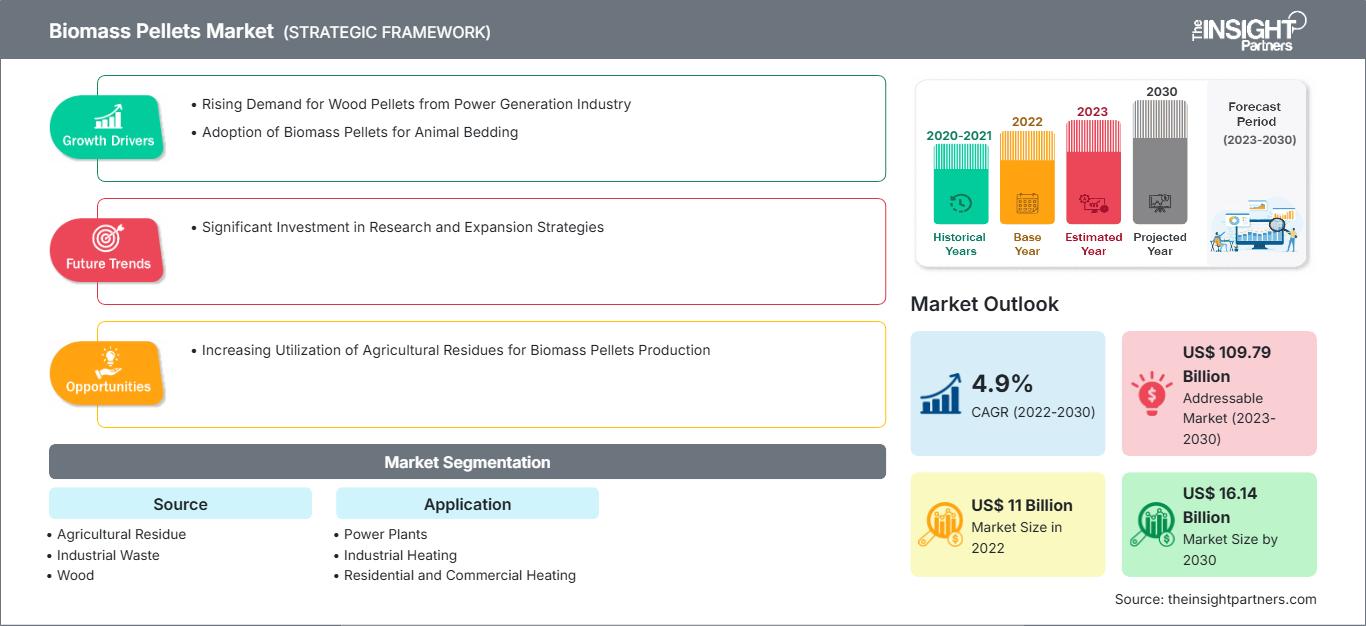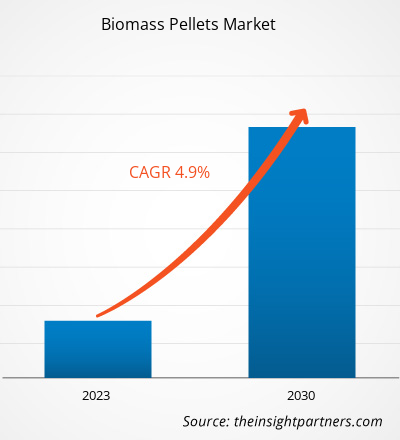[Research Report] The biomass pellets market size was valued at US$ 11,001.59 million in 2022 and is expected to reach US$ 16,137.89 million by 2030; it is estimated to register a CAGR of 4.9% from 2022 to 2030.
Market Insights and Analyst View:
Biomass pellets are high-density, processed biomass compressed in small cylindrical form. It is derived from organic materials, such as agricultural residue, wood waste, wood chips, sawdust, and forest residue. Biomass pellets are used in power generation as well as heating applications in residential, commercial, and industrial sectors. It has many advantages over unprocessed biomass, such as standardized characteristics, high energy content, storage feasibility, and ease of transportation. Biomass pellets, namely wood pellets, are widely used in residential pellet stoves and boilers. The government's efforts to reduce greenhouse gas emissions and promote the utilization of biomass pellets is driving the biomass pellets market growth.
Growth Drivers and Challenges:
With the growing focus on sustainability, the demand for biomass pellets such as wood pellets has increased significantly. Wood pellets can be utilized for electricity production as an alternative to coal feedstock. Further, biomass pellets are uniformly shaped, possess high density, and are feasible for transportation and storage. The demand for wood pellets has substantially grown for power generation applications. In Europe and North America, as well as in Asian countries such as China, Japan, and South Korea—wood pellets are primarily used for co-firing at coal-fired power plants. There is a rise in the utilization of alternative materials for coal in large-scale power plants worldwide. In 2021, the Ministry of Power of India mandated at least 5% utilization of biomass pellets in fuel-mix with coal in all coal-fired power plants. Such mandates are driving the growth of the biomass pellets market in India. Further, the large-scale power utilities in several European countries such as the Netherlands and Belgium sourced biomass pellets from the US, Russia, and Canada, as per the United States Department of Agriculture. Thus, the rising demand for wood pellets from the power generation industry is driving the biomass pellets market. Biomass pellets are derived from organic materials such as wood, agricultural residue, and industrial wastes. Many countries consider biomass pellets as a sustainable fuel source; however, there are several environmental concerns related to biomass pellets. The combustion of biomass pellets releases pollutants in the air, including particulate matter, nitrogen oxides, and volatile organic compounds. Further, the production of biomass involves a significant amount of water consumption for processing. Hence, the environmental concerns pertaining to biomass pellets are hampering the biomass pellets market growth.
Customize This Report To Suit Your Requirement
You will get customization on any report - free of charge - including parts of this report, or country-level analysis, Excel Data pack, as well as avail great offers and discounts for start-ups & universities
Biomass Pellets Market: Strategic Insights

-
Get Top Key Market Trends of this report.This FREE sample will include data analysis, ranging from market trends to estimates and forecasts.
Report Segmentation and Scope:
The global biomass pellets market is segmented on the basis of source, application, and geography. Based on source, the biomass pellets market is segmented into agricultural residue, industrial waste, wood, and others. Based on application, the biomass pellets market is segmented into power plants, industrial heating, residential and commercial heating, and others. By geography, the biomass pellets market is segmented into North America (US, Canada, and Mexico), Europe (Germany, France, Italy, UK, Russia, and Rest of Europe), Asia Pacific (Australia, China, Japan, India, South Korea, and Rest of Asia Pacific), Middle East & Africa (South Africa, Saudi Arabia, UAE, and Rest of Middle East & Africa), and South & Central America (Brazil, Argentina, and Rest of South & Central America)
Segmental Analysis:
Based on source, the biomass pellets market is segmented into agricultural residue, industrial waste, wood, and others. The wood segment held the largest share in the biomass pellets market and is expected to register significant growth over the forecast period. Biomass pellets are manufactured using wood wastes such as sawdust, wood chips, wood shavings, bark, and other residual materials generated from woodworking, sawmills, and timber processing. The wood waste is collected, processed, dried, and pelletized. Wood biomass pellets are widely used in residential heating applications, industrial furnaces, and power plants.
Regional Analysis:
Based on geography, the biomass pellets market is segmented into five key regions—North America, Europe, Asia Pacific, South & Central America, and Middle East & Africa. The global biomass pellets market was dominated by Europe, which accounted for ~US$ 6,478 million in 2022. Asia Pacific is the second-largest contributor, which recorded more than 30% of the global biomass pellets market share in the same year. North America is expected to register a CAGR of over 4.5% during the forecast period. In North America, the biomass pellets market is significantly driven by the regional cost competitiveness of biomass pellets as compared to residential heating oil and propane. The production of wood pellets in North America has gained traction over the past few years due to rising demand from overseas markets. According to the United States Department of Agriculture, the US and Canada supply wood pellets to power plants in the Netherlands and Belgium. The increase in domestic demand for biomass pellets in the region has prompted manufacturers to expand their production capacities. In 2023, Grand River Pellets (Canada) invested US$ 30 million to expand the biomass pellets production capacity from 140,000 to 220,000 metric ton per year. All these factors are driving the biomass pellets market growth in North America.
Industry Developments and Future Opportunities:
Various initiatives taken by the key players operating in the biomass pellets market are listed below:
- In September 2022, Enviva Inc inaugurated its newly constructed wood pellet manufacturing facility in George County, Mississippi (US). The plant started production activities at the beginning of 2022 to reach an annual permitted production capacity of 750,000 metric ton per year (MTPY).
- In April 2022, Drax Group PLC opened a new pellet plant at Demopolis in Alabama, the US. The plant produces sustainable biomass pellets annually from sawmill residues such as sawdust, chips, and shavings.
- In December 2020, Pure Biofuel Ltd. launched ENPOWER wood pellets. ENPOWER wood pellets bags incorporate A1 quality standards, which are set out by the UK Pellet Council and the European Council. This product is available in 10-kg or 15-kg packets.
- In April 2021, Drax Group PLC acquired Pinnacle Renewable Energy Inc. With the acquisition, Drax Group PLC delivered bioenergy with carbon capture and storage (BECCS), permanently removing carbon dioxide from the atmosphere yearly.
- In May 2023, LEAG Group acquired Wismar Pellets GmbH from Metropolitan Equity Partners, a private equity investor, in a bidding process to expand the production and supply portfolio of its refining operations. This acquisition will help LEAG Group to serve a larger number of customers.
The regional trends and factors influencing the Biomass Pellets Market throughout the forecast period have been thoroughly explained by the analysts at The Insight Partners. This section also discusses Biomass Pellets Market segments and geography across North America, Europe, Asia Pacific, Middle East and Africa, and South and Central America.
Biomass Pellets Market Report Scope
| Report Attribute | Details |
|---|---|
| Market size in 2022 | US$ 11 Billion |
| Market Size by 2030 | US$ 16.14 Billion |
| Global CAGR (2022 - 2030) | 4.9% |
| Historical Data | 2020-2021 |
| Forecast period | 2023-2030 |
| Segments Covered |
By Source
|
| Regions and Countries Covered |
North America
|
| Market leaders and key company profiles |
|
Biomass Pellets Market Players Density: Understanding Its Impact on Business Dynamics
The Biomass Pellets Market is growing rapidly, driven by increasing end-user demand due to factors such as evolving consumer preferences, technological advancements, and greater awareness of the product's benefits. As demand rises, businesses are expanding their offerings, innovating to meet consumer needs, and capitalizing on emerging trends, which further fuels market growth.

- Get the Biomass Pellets Market top key players overview
COVID-19 Impact:
The COVID-19 pandemic affected almost all industries in various countries. Lockdowns, travel restrictions, and business shutdowns in North America, Europe, Asia Pacific (APAC), South & Central America, and the Middle East & Africa (MEA) hampered the growth of several industries, including the chemical & materials industry. The shutdown of manufacturing units of biomass pellets companies disturbed global supply chains, manufacturing activities, and delivery schedules. Various companies witnessed delays in product deliveries and a slump in sales of their products in 2020. Most of the power plants and industrial plants were shut down during the pandemic, decreasing the consumption of biomass pellets. In addition, the pandemic has caused fluctuations in biomass pellets prices. However, various industries revived their operations after supply constraints were resolved. Moreover, the rising demand for biomass pellets from the industrial and residential sectors is substantially promoting the biomass pellets market growth.
Competitive Landscape and Key Companies:
A few players operating in the global biomass pellets market include Drax Group Plc, Enviva Inc, AS Graanul Invest, Lignetics Inc, Valfei Products Inc, Mallard Creek Inc, Energex American Inc., Wismar Pellets GmbH, UAB Redal Ltd, and Premium Pellet Ltd. Players operating in the global biomass pellets market focus on providing high-quality products to fulfill customer demand.
Frequently Asked Questions
Can you list some of the major players operating in the global biomass pellets market?
Which region held the largest share of the global biomass pellets market?
Based on source, which segment is leading the global biomass pellets market during the forecast period?
What are the key factors influencing market growth?
Which region held the fastest CAGR in the global biomass pellets market?
Based on application, which segment is leading the global biomass pellets market during the forecast period?
- Historical Analysis (2 Years), Base Year, Forecast (7 Years) with CAGR
- PEST and SWOT Analysis
- Market Size Value / Volume - Global, Regional, Country
- Industry and Competitive Landscape
- Excel Dataset
Recent Reports
Related Reports
Testimonials
Reason to Buy
- Informed Decision-Making
- Understanding Market Dynamics
- Competitive Analysis
- Identifying Emerging Markets
- Customer Insights
- Market Forecasts
- Risk Mitigation
- Boosting Operational Efficiency
- Strategic Planning
- Investment Justification
- Tracking Industry Innovations
- Aligning with Regulatory Trends





















 Get Free Sample For
Get Free Sample For